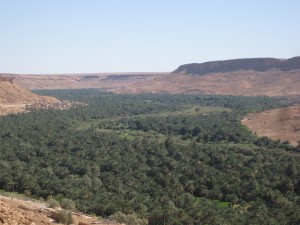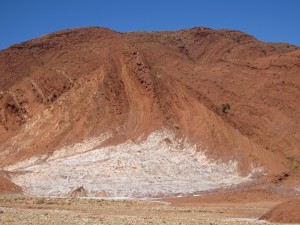
This is our first clear view of the Tafilalt—a palmerie we have been following for the past 40 minutes from Errachidia. We look down over a sprawling river of green, stretching for miles to the north and south. This roadside stop hangs over the top of the oasis, which seems to fill in an immense crevasse opening up the surface of the desert. The heat is oppressive: Jeremy tries to stand in the shade I cast. Down below, the palmerie looks cool and lush.

Eric Ross, AUI geographer, is walking us through a brief introduction to the oasis. “First, I want you to forget everything you think you know about oases. Forget Hollywood images of waving palm trees and limpid pools of water; forget the myth of effortless fertility. An oasis is an agricultural system,” Eric announces, gesturing at the lush river of green below us.
“Water alone is not enough,” John Shoup adds. “Add water to desert and you get a salt marsh, not an oasis.”
A student hand goes up. “Why a salt marsh? Is there salt in the sand?”
Eric shakes his head. “Evaporation.” John clarifies: “There’s salt in the water.”
I’ve seen that salt, crusting on the red rocks, marking the dry riverbeds near Telouet. There are salt mines in the area, too, so I’d guess the salt passes into the water from the rock in the mountains.


But Eric is speaking, repeating his point for emphasis. “An oasis is a complex system of irrigation and husbandry: incredibly labor intensive, but also highly productive. In fact, a thriving oasis is the most productive agricultural system in the world in terms of output per hectare—more productive than the often-cited rice paddies of southeast Asia.”
Eric continues his explanation. “A healthy oasis has three productive levels. Palms go in first, because their roots are bulbs, like tulips, and they help hold water in the soil. Their fronds also provide some small measure of shade, which is important for the crops that follow. The middle layer consists of fruit trees: pomegranates and figs, olives and citrus. The bottom level produces vegetables, onions, and also forage crops like alfalfa to feed donkeys, sheep, etc., since there is no open grazing land.

“This, unlike the oases we’ll see further south, is a thriving oasis, and it is the second largest oasis of the Sahara, second only to the Nile. In the sites we’ll visit tomorrow, further downstream, the middle layer has vanished: fruit trees are no longer sustainable, given the greater scarcity of water.
“The oases in Morocco differ from those in western Egypt: in Egypt, the oases are produced through artesian wells, and the oasis is based on the distribution of water from the center to the periphery. Moroccan oases are all based on surface water that flows down from the mountains: the sandstone of these mountains does not absorb water.
“The labor needed for an oasis to thrive is organized according to a complex social system. There are four classes (not unlike the caste system of India), of which only two classes can own property. All of the property in an oasis is privately owned, but the water rights are more commonly collective, and those rights are administered tribally. The water rights of individual families are measured in terms of hours of irrigation per year, and those hours are defined in part by the amount of rain in a given year. The man administering water rights has memorized the ancestry of each land-owner and the percentage of water from each irrigation channel that eventually leads to the calculation of irrigation hours due.
“If someone outside the landowner classes of the village attempts to buy land, both the seller and the buyer are fined by the community, and upon the buyer’s death, the land reverts to the seller’s family. Buyers from outside the landowning class cannot acquire land to pass on to their descendants.
“Conversely, everyone from a landowning family inherits, leaving the land to be ever more finely parsed. Eventually, one might inherit a single tree, leaving one’s children to inherit a portion of a tree, while one’s grandchildren inherit a still smaller fraction of a tree. An entire family can live for a year on the proceeds from a single tree’s fruit, so even a fraction of a tree is not an inconsiderable inheritance—as long as one has the water needed for that tree to thrive.”

“The importance of water, along with its scarcity, means that oases have historically been sites of much social violence: raiding from one tribe to another, raiding herds, raiding grain reserves. This can be seen in the architecture: each house is a little fortress, each village is a little fortress. But we’ll see more of this tomorrow.”
